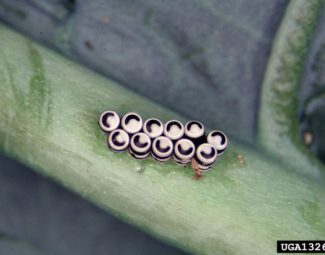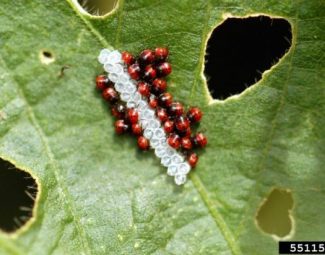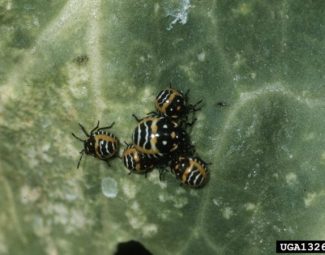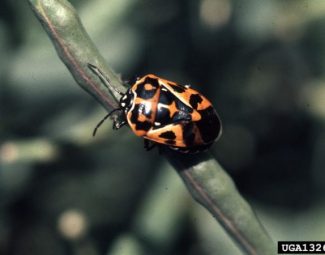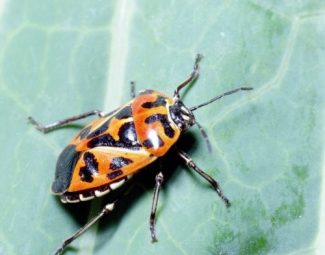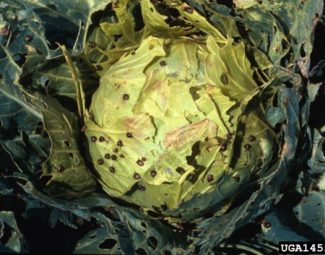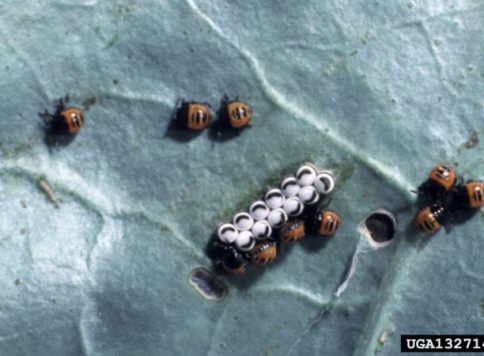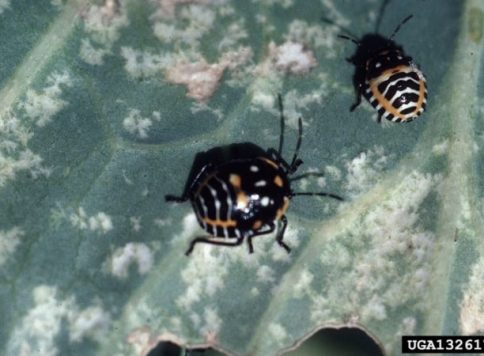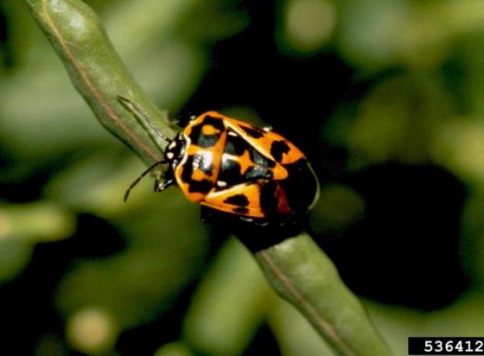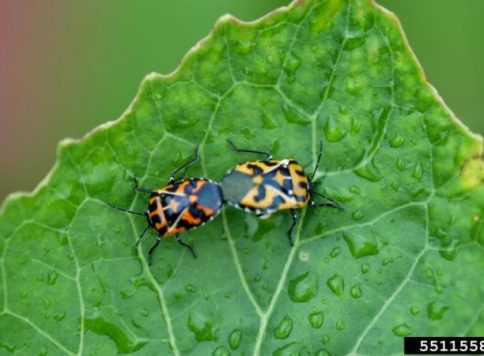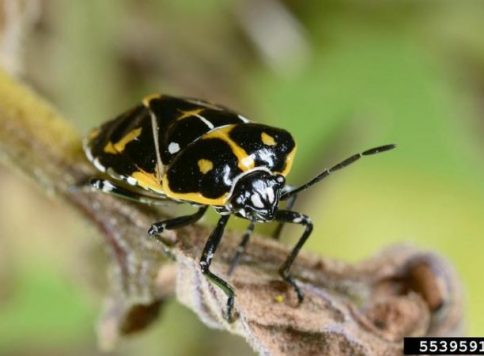Harlequin Bug
Insect Summary Report
Murgantia histrionica
General Information
- Preferred crops include: horseradish, cabbage, cauliflower, collards, mustard, Brussels sprouts, turnip, kohlrabi and radish. Can also be seen on tomato, potato, eggplant, okra, bean, asparagus, beets, and fruit trees.
- Has ability to destroy entire crops if left uncontrolled.
- Browning, wilting, and eventual death of host plants can occur under intense feeding conditions. Younger plants have a lower threshold for damage than younger plants.
- Incorporates glucosinolates from crucifer plants, which are undesirable to birds.
- Males produce aggregation pheromone to attract other feeding individuals.
Life Cycle 50-80 Days
- Eggs… (4-29 Days) White and black striped, keg shaped. Usually laid in rows of two in groups of around 12.
- Nymph… (4-9 Weeks) 5-6 molts. Orange and black. Coloration goes from pale orange to more defined colors in older stages. Pierce host with mouthparts and extract sap.
- Adult… Red and black spotted. About 3/8 in. Back has distinct “X” marking. Female produces approx. 115 eggs during lifetime.
Over-wintering Strategy
- No diapause, but life cycles are extended in the winter, which results in low populations.
- Seek shelter during cold temperatures in winter by hiding under grass cover, rubbish piles, and other insulating materials.
- Adults are usually the only stage to survive winter conditions.
Organic Control
- General Info
- Plant a small acreage of a non-market preferred host such as turnip, kale or mustard in the spring before market crops are grown to serve as a trap crop. Monitor and Some type of control is necessary to avoid the trap crop becoming a source of infestation.
- “Rolly Polly” bugs are predators. Mulching of seedbeds will provide habitat for these predators.
- Commonly Used Products
- Ferti-Neem Oil
- Ferti-Organics Karanja Oil
- Biorepel (Garlic Oil)
- Neemix 4.5 (Botanical)
- Pyganic 1.4 (Botanical)
- Pyganic 5.0 (Botanical)
- Ecotrol Plus (Botanical Oil)
- Soaps: Des-X
- Mycotrol ESO (Biological)
- BoteGHA ES (Biological)
Cultural Control
- Clear away brush piles, grass thickets, rubbish, and any other material that may serve as insulation during cold temperatures.
- Plastic row covers early in the year to protect vegetation from egg lay and pest feeding.
- Maintain control of weeds such as wild mustard, sheperdspurse, peppergrass, bittercress, and watercress.
- Some resistant varieties listed below
| Vegetable | Cabbage | Collards | Cauliflower | Radish |
| Variety | Copenhagen Market 86, Headstart, Savoy Perfection Drumhead, Stein’s Flat Dutch, and Early Jersey Wakefield | Green Glaze, Georgia (3) | Early Snowball X, Snowball Y | Red Devil, White Icicle, Cherry Belle, Champion, Red Prince, Globemaster |
More Images of the Harlequin Bug
Bibliography
- Images by Ward Upham, Kansas State University, Bugwood.org (newly hatched nymphs and head to head adults)
- Image by Edward L. Manigault, Clemson University Donation Collection, Bugwood.org (nymph in palm)
- Images by Whitney Cranshaw, Colorado State University, Bugwood.org (eggs, egg mass on cabbage, adults on canola, cabbage injury by nymphs, and damage to whole cabbage)
- Images by Joseph Berger, Bugwood.org (adults close up)
- Images by Clemson University – USDA Cooperative Extension Slide Series, Bugwood.org (adults on cabbage)
- Image by Alton N. Sparks, Jr., University of Georgia, Bugwood.org (egg mass with immatures)
- http://creatures.ifas.ufl.edu/veg/leaf/harlequin_bug.htm Marie A. Knox, University of Florida, Publication Number: EENY-25, Publication Date: February 1998. Latest revision: September 2005. (Life cycle, over-wintering, damage)
- http://edis.ifas.ufl.edu/BODY_IG150 S. E. Webb, associate professor, Entomology and Nematology Department, Cooperative Extension Service, Institute of Food and Agricultural Sciences, University of Florida, Gainesville, 32611-0640. ENY-464, Published: July 2002. Revised: September 2007. (Life cycle, conventional control)
- http://attra.ncat.org/calendar/question.php/2006/03/06/p1903 (resistant varieties, natural predator)
- http://www.ivyhall.district96.k12.il.us/4th/KKhp/1insects/harlequin.html (weed hosts, host crops)
- Zahn, D.K., Moreira, J.A., and Millar, J.G. 2008. Identification, synthesis, and bioassay of a male-specific aggregation pheromone from the harlequin bug, Murgantia histrionica. J. Chem. Ecol. 34:238-251.
- A. Aliabadi, J.A. Renwick, and D.W. Whitman “Sequestration of glucosinolates by harlequin bug Murgantia histrionica” Journal of Chemical Ecology, Sept 2002

